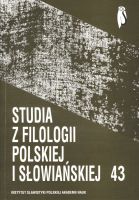Razgraničavanje jezičnih entiteta na osnovi modela (ne)identičnosti
Boundary Determination of Language Entities on the Basis of (Un)Identity Models
Author(s): Petra Košutar, Branka TafraSubject(s): Language and Literature Studies
Published by: Instytut Slawistyki Polskiej Akademii Nauk
Summary/Abstract: A comprehensive model has been elaborated which determines sameness, equivalence and diversity relations. Sameness is the relation in which only one entity stands opposite to itself, in which there is a quantitative and qualitative identity. a = a is the same (Felix the cat is Felix the cat), but a = b is the same as well if a = c and b = c (Ljubo Babić is Ksaver Šandor Gjalski). Equivalence is the qualitative identity which denotes partial or complete correspondence of common properties of two or more entities. a ≈ b (Two copies of the fifth Harry Potter sequel are the same). Diversity is an unidentity. a ≠ b (A beech is not an oak). Unidentity model can be applied to the idioms interrelation in central South¬ Slavic language area, whether they are studied in terms of the genetic linguistics or sociolinguistics. To determine their boundaries, their relation should be determined first.
Journal: Studia z Filologii Polskiej i Słowiańskiej
- Issue Year: 2008
- Issue No: 43
- Page Range: 177-206
- Page Count: 30
- Language: Croatian

